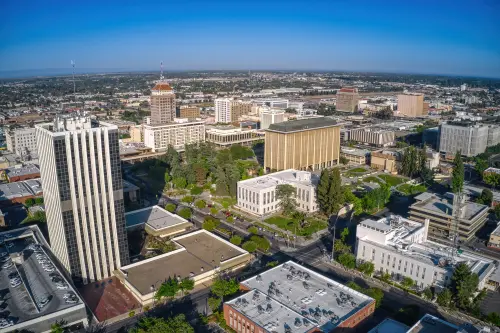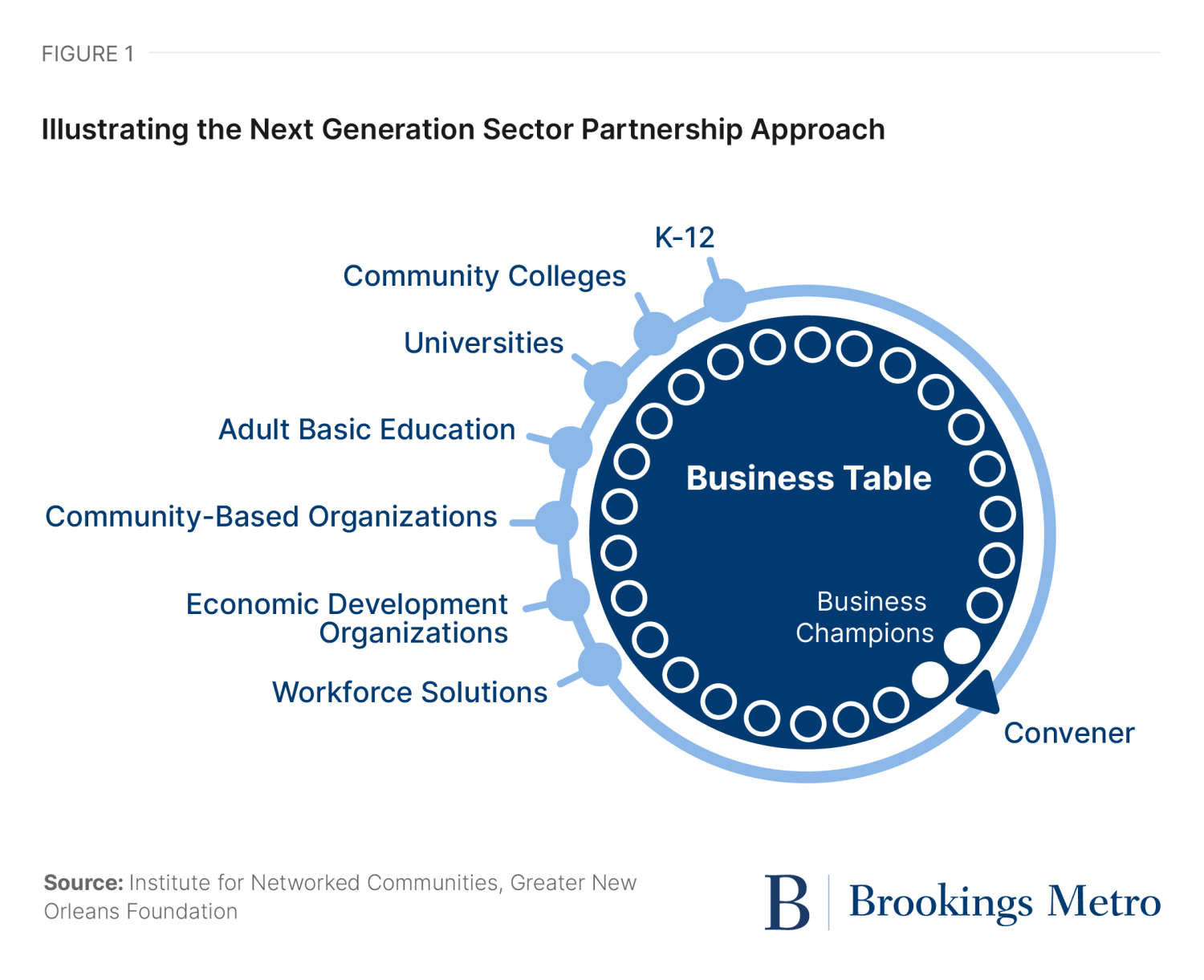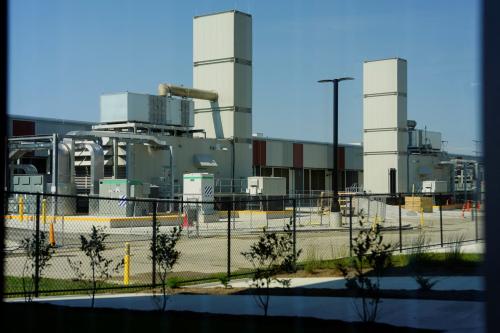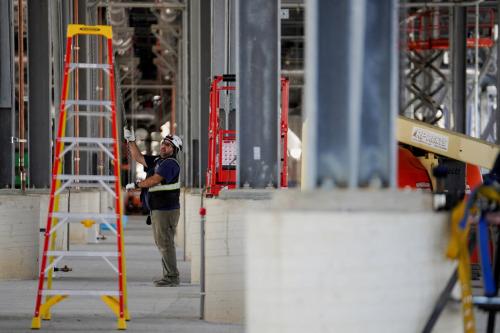Since Hurricane Katrina, New Orleans has aimed not only to rebuild, but to fundamentally transform its economy. However, siloed workforce development systems have been a persistent barrier to developing the talent that industry needs to grow and advance, preparing and connecting residents for high-demand jobs in the region’s most important sectors, and creating the conditions for workers to persist and advance in their careers. This case study examines how a local proposal for the federal Good Jobs Challenge that was not selected for funding still spurred philanthropic and industry partners to build a robust foundation for sector partnerships, and then launch those partnerships. Key takeaways for regional civic and philanthropic leaders include:
- Philanthropic resources can be uniquely helpful in activating firms to collaborate, particularly in sectors that have little or no history of partnership, or may even be competitors. While sector partnerships require business leadership, by providing upfront “risk capital,” foundations can demonstrate the value proposition of collaboration and shared investment in systems and programs that benefit all.
- Mobilizing funding over time requires robust tools and processes to assess the performance of programs and systems, as well as document their impact on high-level economic objectives. Continuous evaluation enables accountability, informs adaptation, and sustains alignment between both worker needs and industry priorities.
The case study series
Between 2021 and 2022, the federal government passed major legislation authorizing nearly $4 trillion in economic investment, including $80 billion in place-based industrial policy. Brookings has been tracking these investments, including the early implementation of coalition-based grants aimed at advancing key national priorities such as national security and economic and technological competitiveness.
This case study is part of a report series that goes beyond the programmatic efforts catalyzed by these investments to examine the underlying civic infrastructure that regions have begun to build—and will ultimately need to sustain in the long term—to support resilient, inclusive, and innovation-driven economies.
The main report details five functions that regions need, with a particular focus on the unique role of local philanthropy in supporting these functions, both as funders and strategic partners. The five functions are:
- Connect networks and build trust among increasingly disconnected economic actors, including business leaders, community organizations, students, and entrepreneurs.
- Orient regional stakeholders toward a shared understanding of the economy and the pathways to inclusive growth.
- Activate key business leaders to inform, engage, and invest in strategic regional inclusive growth efforts.
- Integrate teams of diverse, complementary organizations to solve specific, high-priority challenges using evidence-based interventions.
- Mobilize resources through sustainable financial models to maintain momentum, using performance measurement tools to identify the highest-priority areas for investment.
The five case studies—Chicago/Illinois; Fresno, Calif.; New Orleans; Syracuse, N.Y.; and Tulsa, Okla.—illustrate how these functions and the philanthropic leadership that enables them play out on the ground. Each region has received different forms of federal funding under the 117th Congress, and also varies in size, geography, and maturity of economic and workforce development ecosystems—thus offering lessons for a range of philanthropic and civic leaders across the country.
Background
New Orleans’ economy has historically relied on the oil and gas sectors (which face long-term environmental and economic challenges) as well as hospitality and tourism, which remain vital to the city’s identity but have long struggled to provide equitable wages and opportunities for advancement for workers. The region’s economic performance has lagged: Median wages in New Orleans remain below national averages, and economic inclusion metrics indicate persistent disparities, especially among communities of color. For example, Black households comprise 36% of the New Orleans metro area but hold just 11% of the region’s household wealth—a gap driven in part by Black residents being underrepresented in high-wage, high-growth occupations, and overrepresented in industries with limited wealth-building potential.
New Orleans boasts a vibrant nonprofit ecosystem, but stakeholders universally acknowledge it as stretched-thin and undercapitalized. Isabel Barrios, director for disaster recovery and resilience at the Greater New Orleans Foundation (GNOF, the regional community foundation that makes grants and leads what they call “transformative civic projects”), underscored this critical lack of local nonprofit infrastructure capacity: “The region is at least 30 years behind in terms of CDFI [community development financial institution] capacity,” she said, as an example of a constraint in attracting and investing essential federal and private capital in marginalized communities. The harsh lessons of Hurricane Katrina remain instructive. Despite substantial funding inflows following the disaster, Barrios observed, “Those dollars did not effectively penetrate underserved communities.”
Efforts to drive equitable investment and inclusive growth have been stymied by an oft-overlooked challenge: Workforce development and educational institutions largely operated in silos, separate from economic development initiatives and industry leadership driving business investments and job creation. This lack of alignment affected both local-serving industries such as health care as well as traded sectors such as advanced manufacturing.
A change in perspective at GNOF (which has an annual operating budget of $7 million) from approaching workforce development from a primarily supply-side orientation focused on the immediate needs of low-wage workers and job seekers, to a dual-customer approach that engages industry to better understand and address talent demands and identify demand-side barriers, has ushered in a new workforce system strategy that is beginning to bear fruit. A similar shift was necessary in the field of economic development. Daphine Barnes, executive director of economic mobility at Greater New Orleans, Inc. (GNO, Inc.), the regional economic development entity, explained that while her organization has long worked to address workforce needs at both the business and systems level, the region is now taking a deeper dive into sector-based strategies. This more sustained, collaborative model is gaining traction with industry, as economic developers recognize that structured, employer-driven partnerships “provide long-term value.”
How civic and philanthropic leaders are mobilizing federal resources
Recognizing the structural challenges that have inhibited cross-sector collaboration on workforce development, regional leaders including the New Orleans Office of Workforce Development initiated an application in 2023 for the Economic Development Administration’s Good Jobs Challenge (GJC), aiming to secure a portion of the $500 million competitive federal funding created by the American Rescue Plan Act (ARPA). The city’s proposal emphasized establishing employer advisory boards designed to regularly guide training providers, ensuring alignment between workforce curricula and industry needs.
Though the $25 million proposal did not secure federal funding, the application process generated significant local momentum. The proposal, for example, highlighted the urgent need for more robust industry engagement in workforce development, stating that workforce development efforts in the region “have been ad hoc and too often focused on a particular employer or cluster of employers, occupation, or training provider.” In the words of GNOF’s Director for Workforce Programs Kristina Kent, the experience of applying for the grant made clear that “by supporting the economic vitality of industry in our region, we were more likely to grow and sustain good jobs over time.” GNOF seized the opportunity to lead an evolution of the workforce strategy toward one that was far more employer-driven, and the city of New Orleans dedicated $400,000 in ARPA funds it had already received to each of the four sector partnerships that would emerge from this work.
Guided by a national survey of workforce practices and strategic consultations with key partners such as the city’s Office of Workforce Development, GNO, Inc., and the New Orleans Career Center (NOCC), which provides career and technical education programs citywide, GNOF and its partners recognized the limitations of the initial employer advisory board concept. Seen as too passive and education-focused, they identified a clear need for a more active, employer-driven model.
How philanthropic and civic leaders reimagined employer engagement to launch a new model of sector-based workforce development
The outcome was the adoption of the Next Generation Sector Partnerships approach. Sector partnerships bring business leaders from the same industry and labor market together at a “Business Table” to address workforce and other common needs of the industry. In the model New Orleans adopted, leaders from multiple community-based, economic development, education, industry association, and workforce development organizations are also invited to join a regional team called the “Sector Support Team,” which will partner with industry leaders serving on the “Business Table” on their identified needs.
Often, a sector partnership would be “housed” within a dedicated and independent intermediary tied to the workforce and/or economic development systems, or a credible industry association. But without such an existing entity positioned to lead, GNOF stepped in to start convening the right partners. In particular, GNOF leveraged existing relationships from its long history of funding community-based nonprofits and training organizations, while also bringing industry leaders to the table and putting them in the driver’s seat.
Central to GNOF’s approach was the thoughtful curation of the Sector Support Team, integrating the capabilities and perspectives of leaders and organizations across domains critical to advancing a more effective workforce system. This group is composed of a diverse group of leaders and practitioners, including from nonprofits, workforce development organizations, community colleges, and government partners. They have agreed to be responsible for actively responding to specific objectives raised by industry stakeholders. And they have also agreed to take a structured approach, with standard operating procedures to guide engagement with sector partnerships and coordinate action plans.
GNOF has provided the governance and coordination needed to pilot sector partnerships and activate employer buy-in, and intends to invest essential resources to ensure that pathways in these sectors are accessible to anyone, regardless of socioeconomic background. By stepping into this intermediary role, they have effectively de-risked sector-based workforce initiatives, making it more feasible for employers and industry leaders to invest time and resources. This is a delicate balance: GNOF and its partners need help engaging externally and reforming practices internally with business and industry to support a more effective and inclusive economic development system. But they also need business and industry to feel ownership of the effort in the long run, thinking of it as fundamentally a talent rather than a community impact strategy (or a “must-do” rather than a “nice-to-do” for their business).
Launching partnerships with a ‘coalition of the willing’ and layered investments to fuel inclusive growth
One valuable outcome of the GJC application was a rigorous, data-driven research and stakeholder engagement process led by NOCC and the city of New Orleans to identify the most promising sectors based on growth trajectory, significant unmet talent needs, and potential for creating inclusive, high-wage employment opportunities as highlighted in the city and state economic development strategies. Construction and green infrastructure, health care, transportation and logistics, and advanced manufacturing all emerged as high-potential industries for economic and workforce development alignment and sector partnership.
GNOF has been assuming a “player-coach” role in this work: convening for the construction, green infrastructure, and health care partnerships directly; designing and delivering shared governance and capacity, such as the Sector Support Team, to serve each of the emerging sector partnerships; and funding wraparound supports for participants in sector-partnership-aligned programs as well as a developmental evaluation.
GNOF’s health care and construction sector partnerships have already launched with a “coalition of the willing” made up of employers in each sector that are oriented toward action. Each partnership is organized into action teams. In the health care sector partnership, employers have identified career exploration, workforce attraction and retention, and policy advocacy related to increasing the supply of in-demand clinical and nonclinical roles. In construction, employers have identified strengthening career pathways, expanding re-entry hiring, and policy advocacy related to public incentives and investments for the built environment. GNOF is also raising additional resources for sector-based initiatives from outside funders with a specific interest in those industries.
GNO, Inc., which is convening the advanced manufacturing partnership, and the Port of New Orleans, which is convening transportation, distribution, and logistics, have been leveraging GNOF’s expertise, capacity, and community credibility in designing and launching their sector partnerships. Both of these partnerships are on track to get off the ground in the first half of 2025.
Building durable civic infrastructure to sustain workforce innovation beyond federal funding windows
Fidelity to strategy and accountability is central to GNOF’s strategy to mobilize long-term investment. The organization has been able to inspire and support consistent adherence to the Next Generation Sector Partnerships model across the four sector partnerships, ensuring alignment across industry sectors and uniform engagement with training providers and nonprofits providing wraparound supports. They are also sponsoring a rigorous developmental evaluation, with evaluators meeting biweekly to monitor progress across partnerships. GNOF’s Kristina Kent elaborated: “We meet with the evaluation team every other week and discuss our progress. At the 18-month and three-year marks, we’ll conduct extensive feedback sessions—including focus groups, surveys, and interviews—with every stakeholder from employers to workers, ensuring continuous learning and adaptation.”
Local stakeholders are optimistic, but recognize significant challenges ahead. According to Kent, the critical question remains, “Can we secure long-term buy-in from employers and ensure sustainable financial and organizational structures after initial funding expires?” The early signs are promising. Employers have expressed enthusiasm, recognizing the partnerships’ value in helping them address critical skill shortages. GNOF’s structured approach and clear governance have begun demonstrating real-time alignment between industry needs and training efforts—something stakeholders acknowledge as unprecedented.
Key takeaways for civic and philanthropic leaders
One lesson from this case study is that transformational change in the workforce does not require a large infusion of capital. Instead, limited resources targeted at shared governance, coordination, and trust-building infrastructure can set a foundation for building effective sector partnerships, even in regions with a limited tradition of industry engagement and collaboration in talent development. Sector partnerships can become platforms for aligning public, private, and community actors—but only if they are structured, resourced, and supported in a way that allows employers to shift from passive advisors to active co-creators in shaping talent systems, and only if an actor is willing to take the leadership risk required to galvanize such an effort.. Through the New Orleans example, we can see how a philanthropic organization has focused its leadership not on substituting for business leadership, but on de-risking it.
Second, by taking a functional rather than organizational approach, leaders can sidestep some of the inherently complicated politics that face organizations working together in a regional ecosystem. Because no single function is the exclusive domain of one organization, those organizations can lead in areas where they have strength and credibility, and play multiple roles as needed: sometimes convening, sometimes coordinating, sometimes funding or staffing. There is a tendency for funders to think that a “neat” new initiative layered atop the existing system will rationalize it, but too often, such a solution underappreciates the areas of strength that already exist.
Finally, operational discipline should be considered at least as important as strategic vision in sustaining civic collaboration over time. Regular cycles of evaluation, shared operating procedures, and clear roles and responsibilities build credibility, especially in regions where prior efforts have been episodic or siloed. Leaders looking to embed long-term industry engagement to drive inclusive economic outcomes should pair vision with the mechanisms of follow-through: consistent processes, inclusive governance, and rigorous accountability for outcomes.
Case study series





The Brookings Institution is committed to quality, independence, and impact.
We are supported by a diverse array of funders. In line with our values and policies, each Brookings publication represents the sole views of its author(s).





